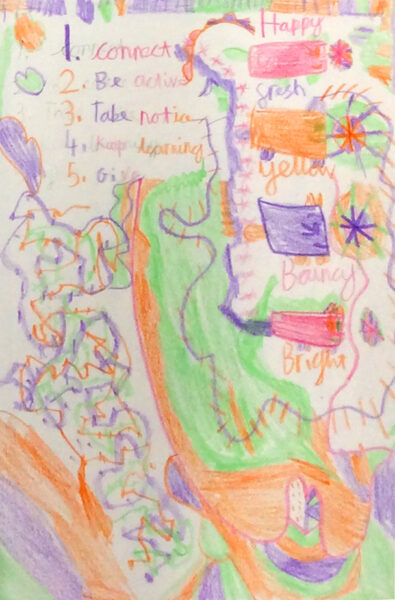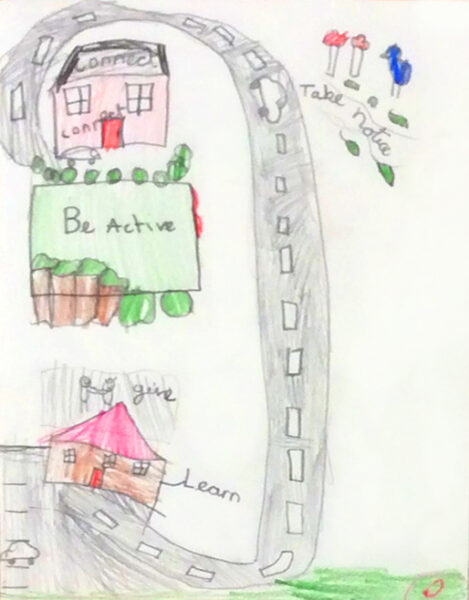For years scientists and politicians have talked about the rise in mental health issues in the UK, particularly amongst children and young teenagers. Today, approximately one in ten children have mental health problems, yet only 30% receive help at a sufficiently young age. However, one local charity and its partners have decided to take an active stand to improve mental health and help people flourish in their community.
MindSpace Stamford is a local charity which aims to promote mental wellbeing through a community approach. At the heart of their message is acknowledging that we all have mental health issues and that we need to find ways to talk about it openly and develop positive routines to look after it.
The local charity has launched the 5 Ways to Wellbeing project in schools in Stamford. The 5 Ways to Wellbeing are five evidence-based steps that we all can take to improve our mental health. They are:
1. Connecting with others
2. Being physically active
3. Learning new skills
4. Giving to others
5. Taking notice of the present moment.

MindSpace Stamford are working In partnership with Art Pop-Up, an innovative non-profit contemporary arts organisation, and local poet Chris Martin on this project. Together they are pioneering the use of a weekly journal for children to reflect, be creative and express themselves while implementing the 5 Ways to mental wellbeing in their daily lives.
Each week, schools receive a letter containing a prompt linked to the 5 Ways to Wellbeing. The prompt is either visual or written. It has even taken the form of a poem. Students are encouraged to respond to the prompt however they wish.
The journal is their private thought log where they can reflect or create while thinking about the five positive steps they can make towards looking after their mental health.
Sam Roddan, the Director of Art Pop-Up and lead artist on the project, believes that there is a crucial connection between creative reflection and good mental health. “I believe that creativity is critical and that everyone can be creative no matter whether they consider themselves ‘good at art’… it is important to give yourself permission to be creative,” Sam explains. “It can be integral to positive mental health.”
As an artist, Sam says he uses journals in three ways:
- as a place to empty out thoughts and emotions when his head is too busy.
- as a space to jot down and play with ideas.
- as a sanctuary to reflect and be mindful.
Importantly, the journal is the child’s own space to play, reflect, doodle, experiment, or simply to take a break from the pressures of daily life. The key message is that there is no right or wrong way to go about it – no teacher is going to mark this book. Children have found this freeing and pressure relieving. “From the 4-year-olds to the teens,” Sam says, “they’ve all told us they find calm and happiness in pausing their day and reflecting, being explicit in how they are looking after their mental health.”

The reactions from students have been incredible. One pupil in Year 4 found the weekly activity “really peaceful and fun” while another said that “at first I thought I couldn’t do it but I tried and it turned into a pattern.” A Year 6 student remarked, “I really like the wellbeing journals. I like that I have my own space to be creative and to do the tasks in the way I like. I like that I have the freedom to choose and that I can take time out to focus on things that make me feel happy and calm.”
One of the weekly prompts titled the ‘Tree of Contrition’ featuring a tree constructed from single-use plastic water bottles, led one 6-year-old to write to her father’s supplier and request they re-evaluate their packaging.
The project has been inspiring for teaching staff too. One Year 6 teacher said that “the Wellbeing project has been a big success in our class. Children look forward to using these every day and find it a really calming task to do. It has been a really positive and engaging way to get the children to reflect on the 5 Ways to Wellbeing.”
Chris Martin, poet and lead creative writer for the project described seeing the first journal responses by the children as a moment of ‘raw excitement’ and so powerful that he spent the whole weekend coming back to look at the images. For Chris, every journal entry still sparks the same energy and curiosity, as each child is coming from a different place and perspective, and each work they produce is equally unique and magical.
The Journals Project has positively impacted the lives of many children in the region and serves as a bastion of positive action for looking after our mental health. However, it shouldn’t stop here. Children and adults across the country are all combatting mental health issues and it is our duty to try and raise awareness of the issue as well as support our local communities, as these wonderful charities have done. Speaking with Carol Hines, the Journals Project leader, I asked her what her message would be to people for looking after their mental health. I’ll leave you with her response: “We all have mental health issues and it is very important to talk about it openly and to take care of it. Try using the 5 Ways to Wellbeing every day as a simple and easy way to feel happier, calmer and to experience the joy of all the positive, simple things in your everyday life.”



